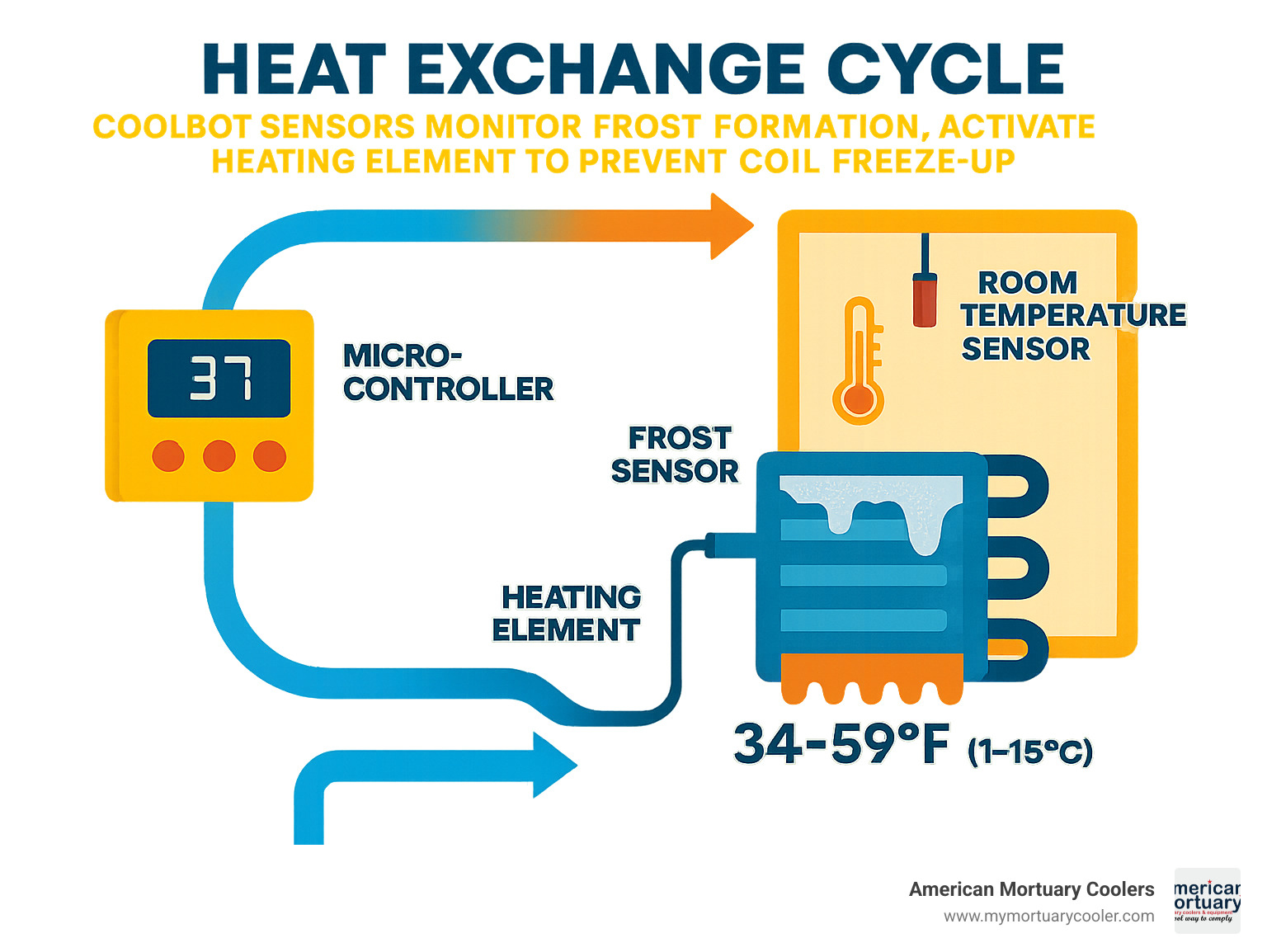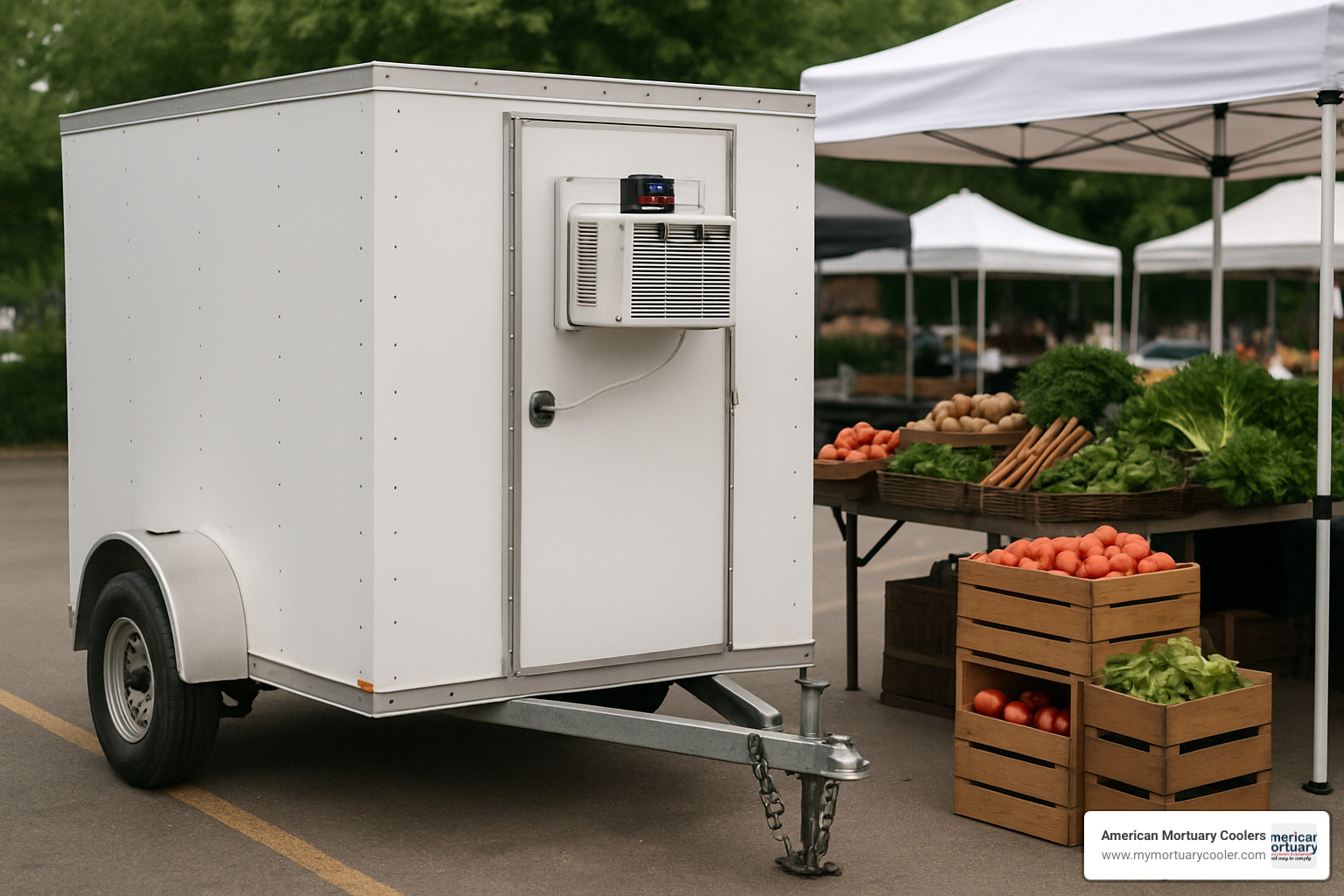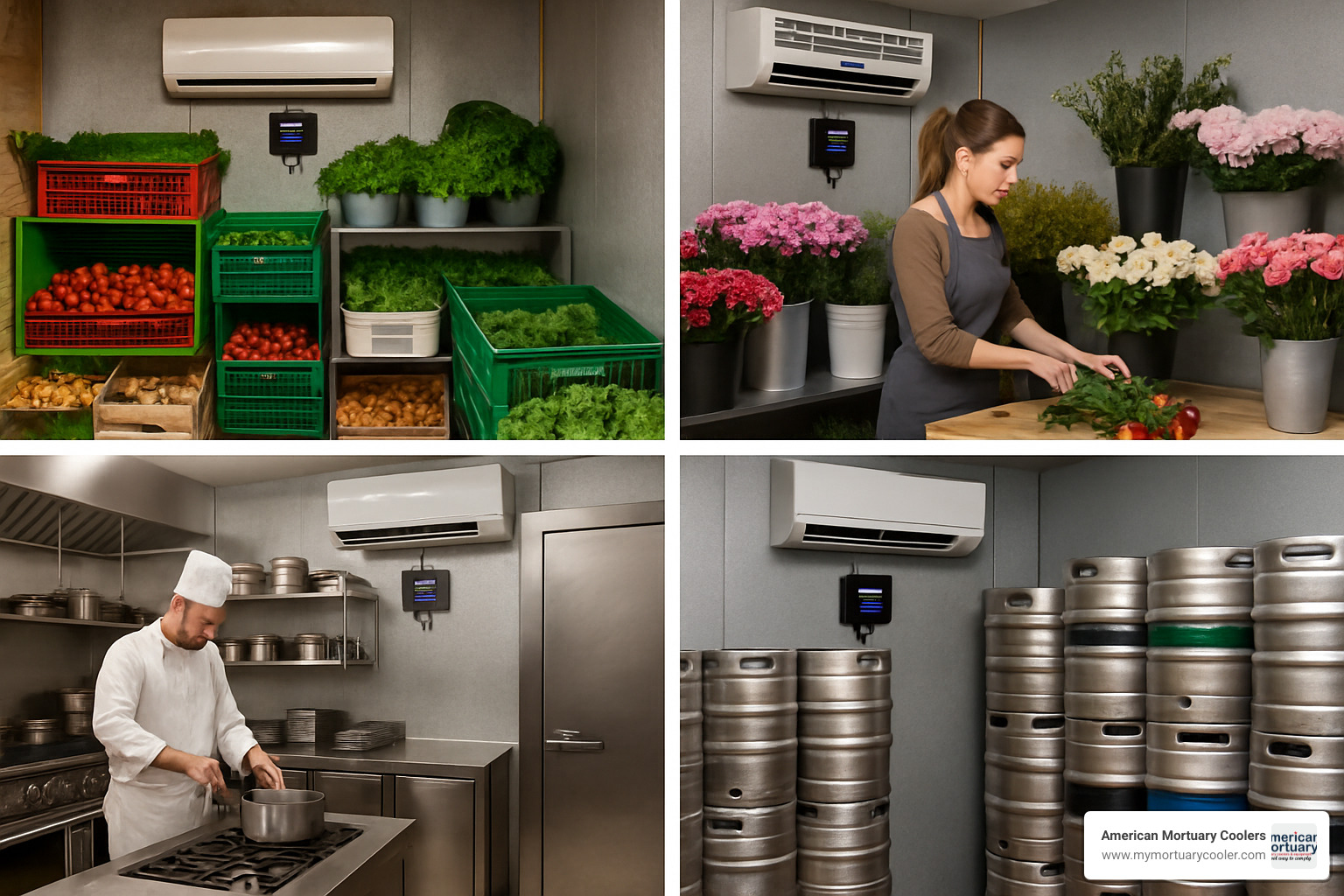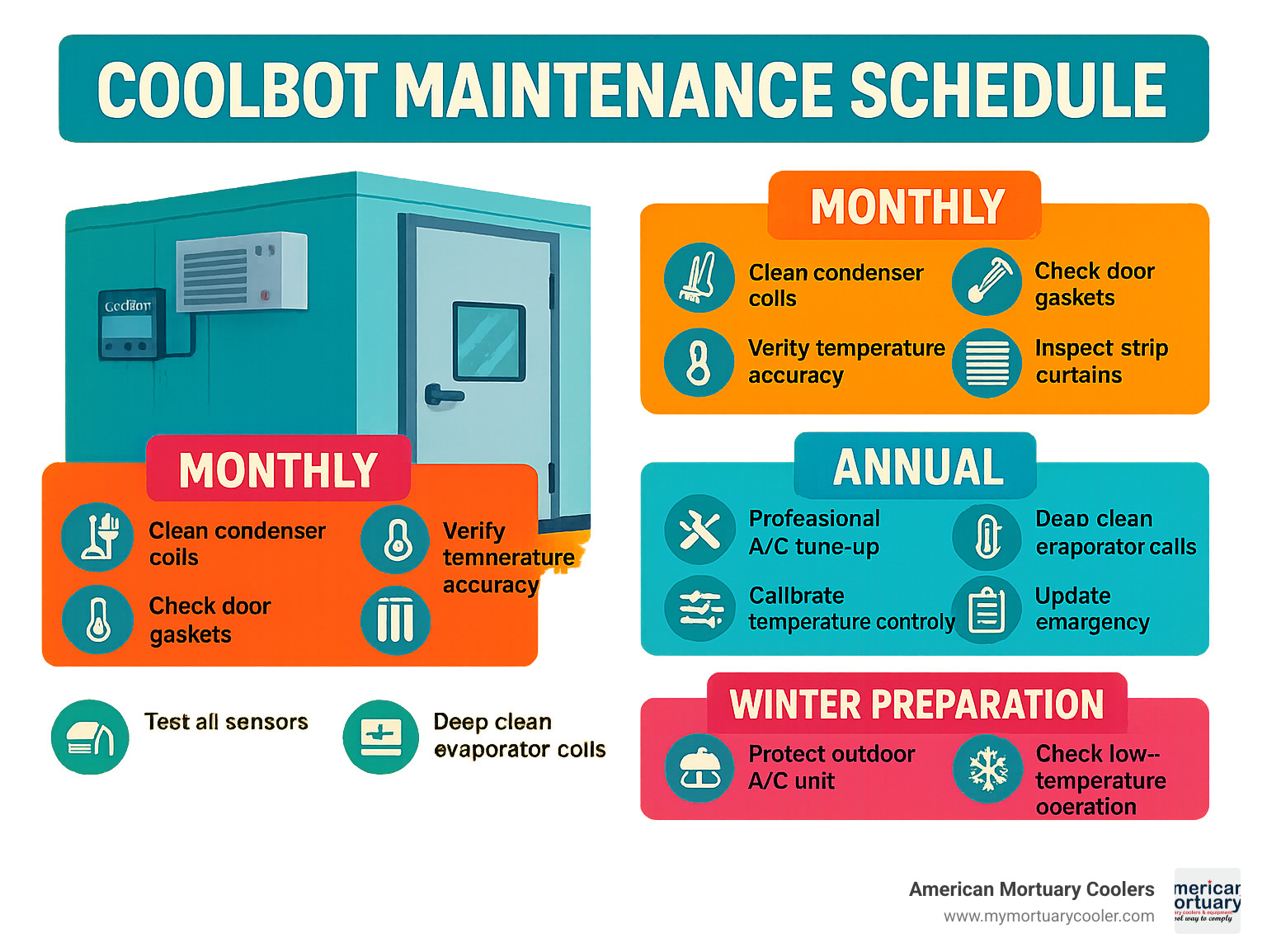Why CoolBot Walk-In Coolers Are Revolutionizing Cold Storage
A coolbot walk in cooler transforms any well-insulated room into professional-grade cold storage using nothing more than a standard window air conditioner and a smart controller. This innovative system has sold over 125,000 units since 2006, saving users up to 72% in upfront costs compared to traditional walk-in coolers.
Quick CoolBot Walk-In Cooler Overview:
- What it is: A $374 controller that tricks window A/C units to reach 34°F
- How it works: Three sensors and a heating element prevent freezing while maintaining cold temps
- Cost savings: Up to 72% upfront, 40% operating costs vs. traditional systems
- Best for: Spaces under 10'×20', opened less than 6 times per hour
- Temperature range: 34°F to 59°F (cannot freeze)
- Installation time: About 5 minutes, no electrical expertise needed
The technology works by using a micro-controller with three sensors that monitor room temperature, coil frost, and the A/C unit's internal sensor. A small heating element prevents the evaporator coils from freezing, allowing the system to reach temperatures as low as 34°F - far below what standard air conditioners can achieve.
CoolBot systems shine in applications like produce storage, floral shops, brewery keg rooms, and even mortuary facilities where reliable, affordable refrigeration is essential. The system can cool most walk-in spaces from ambient temperature to 45°F in about 20 minutes, with another 30 minutes to reach 40°F.
I'm Mortuary Cooler, a national-level mortuary cooler supplier with extensive experience helping funeral homes find cost-effective refrigeration solutions including coolbot walk in cooler systems. My background in mortuary equipment has shown me how CoolBot technology can provide reliable cold storage for facilities with budget constraints or unique space requirements.

Key terms for coolbot walk in cooler:
How CoolBot Walk-In Cooler Technology Works
The coolbot walk in cooler system is essentially a clever hack that turns your ordinary window air conditioner into a professional-grade refrigeration unit. It's one of those "why didn't I think of that" inventions that solves a real problem with neat simplicity.
Here's the issue: Window A/C units are designed to shut off around 60°F to protect themselves from freezing up. That's great for keeping your living room comfortable, but useless if you need to store produce at 35°F or keep flowers fresh at 40°F.
The CoolBot micro-controller solves this with three smart sensors and a tiny heating element. The room temperature sensor monitors the actual air temperature where it matters - in your cooler space. The frost sensor sits right on the A/C unit's evaporator coils, watching for dangerous ice buildup. Meanwhile, the system cleverly bypasses the A/C's internal sensor that would normally shut everything down.
When frost starts forming on those coils, the CoolBot springs into action. It activates a small heater element - just enough to warm that specific spot and prevent freeze-up. The rest of the system keeps cranking out cold air, allowing your coolbot walk in cooler to reach a chilly 34°F without breaking a sweat.
The energy efficiency is impressive too. Traditional walk-in systems use a "bigger is better" approach with oversized compressors that guzzle electricity. Those energy-hungry fans alone can eat up 60% of your power bill. Meanwhile, a basic 8′ × 8′ walk-in cooler compressor might only deliver 8,500 BTUs - less cooling power than a $600 window unit from your local home improvement store.

CoolBot vs. Traditional Refrigeration
The numbers don't lie - coolbot walk in cooler systems deliver serious savings. We're talking 72% less upfront costs and 40% lower operating expenses compared to traditional walk-in coolers. That's real money back in your pocket.
Traditional refrigeration systems are expensive beasts. You're looking at specialized compressors that cost $3,500 or more just for a basic 8×8 setup. Then comes the professional installation with Freon lines, electrical work, and often the need for 220V service. When something breaks, you're calling a technician and paying premium rates.
The CoolBot approach flips this on its head. You buy a window A/C unit from any big box store, plug in the controller, and you're cooling in five minutes. No tools, no electrical expertise, no waiting for installers. The whole system runs on a standard household outlet for smaller units.
| Feature | Traditional System | CoolBot System |
|---|---|---|
| Upfront Cost (8×8 cooler) | $8,000-$12,000 | $2,000-$3,500 |
| Installation Time | 1-2 days professional | 5 minutes DIY |
| Operating Costs | High (inefficient fans) | 40% lower |
| Maintenance | Requires technician | User-serviceable |
| Portability | Permanent installation | Easily relocatable |
| Electrical Requirements | Often 220V dedicated | Standard 115V outlet |
The beauty of this technology is its simplicity. Instead of wrestling with complex refrigeration systems, you're working with proven window A/C technology that's been perfected over decades.
Designing & Building Your CoolBot Walk-In Cooler
Building a coolbot walk in cooler is like assembling a giant refrigerator puzzle - except this one actually saves you thousands of dollars and can be moved if you change your mind about where it goes. The beauty of this system lies in its incredible flexibility, whether you're a weekend warrior building from scratch or someone who just wants to convert that extra room gathering dust.
DIY box construction lets you build an insulated enclosure from standard construction materials. Most folks spend between $2,000-$4,000 for a complete 8×8 setup, which is still a fraction of what traditional systems cost.
Room retrofits are incredibly popular because you're working with existing structure. I know of a Connecticut grower who converted his super-insulated garage into a produce cooler, saving over $500 per month in operating costs compared to his previous traditional system.
For those who want professional results without the construction headaches, turnkey kits offer the best of both worlds. These complete NSF/UL classified enclosures come with matching A/C units and CoolBot Pro controllers. You're looking at about 2 hours of assembly time while still saving thousands compared to conventional solutions.
Mobile trailer builds are perfect for farmers markets, festivals, or operations on rented land. The portability of coolbot walk in cooler systems makes them ideal when permanent installation just isn't practical.

Components Needed for a CoolBot Walk-In Cooler
Every coolbot walk in cooler system starts with the same basic ingredients. The CoolBot Controller is your $374 brain of the operation. The Generation 6 model controls temperatures from 59°F down to 34°F with a digital display. Installation is refreshingly simple - no tools, no electrical expertise, just plug it into your A/C unit and you're ready to go.
Your compatible air conditioner will run you $499-$799 depending on size and features. Window or wall-mounted mini-split units work best, and they need digital displays with automatic restart capability. LG has become the preferred brand after years of reliability testing.
The insulated enclosure is where you have the most flexibility. Whether you build from scratch or buy a kit, proper insulation is absolutely critical. Your walls need to achieve R-25 or better, and don't forget about floor insulation.
Essential accessories include vapor-proof LED lighting, strip curtains to minimize temperature loss, meat and game rail systems for hunters, external ramps, and door options in 36", 42", and 48" widths.
Sizing a CoolBot Walk-In Cooler for Your Needs
Getting the size right is crucial for coolbot walk in cooler performance. The technology works best with coolers under 10'×20' in size, opened fewer than six times per hour, and very well insulated.
Room dimensions follow logical patterns. A 6'×8' space holds up to 80 boxes of produce. Move up to 8'×8' for 144 boxes - a popular mid-size option. An 8'×12' space accommodates 216 boxes, while a 10'×20' space at the maximum recommended size holds up to 360 boxes.
BTU requirements scale with room size. A 6'×8' room needs a 10,000 BTU A/C unit, while an 8'×8' room requires 12,000 BTU. An 8'×10' room jumps to 15,000 BTU, and an 8'×12' room needs 18,000 BTU. The largest recommended sizes require 21,000 and 25,000 BTU units respectively.
Door opening frequency is critical - the system performs best with fewer than six door openings per hour. Every time that door opens, warm humid air rushes in and your system has to work overtime to remove it.
For detailed sizing guidance, CoolBot's online sizing calculator is invaluable, or call their technical support at 888-871-5723. For comprehensive planning, our guide on walk-in cooler design covers the broader considerations.
Choosing the Right Air Conditioner
Selecting the right A/C unit can make or break your coolbot walk in cooler project. Required features are non-negotiable: digital display, automatic restart capability, and window or wall-mounted mini-split designs only.
Several types are completely incompatible: portable air conditioners, central air systems, RV or roof-mount units, PTAC units, and cassette-type ceiling units.
LG is the preferred brand based on extensive field testing. Models like the LG LW1822IVS (18,000 BTU) have proven reliable in thousands of installations. Other compatible brands include select models from Frigidaire, GE, Haier, and Arctic King.
You can purchase compatible units from major retailers including Home Depot, BUILD.COM, LOWES.COM, BESTBUY.COM, AMAZON.COM, and WALMART.COM. Always buy new units from reputable sellers.
Sizing tips go beyond simple square footage calculations. Use CoolBot's online A/C size calculator rather than relying on the box ratings. Allow 2 feet of clearance around A/C vents. In hot climates where ambient temperatures exceed 90°F, consider oversizing by 20-30%.
Insulation & Construction Best Practices
Proper insulation is the difference between a successful coolbot walk in cooler and an expensive lesson in thermodynamics. Walls need R-25 minimum, with R-30+ being preferred. Ceilings require R-30 minimum. Floors are often overlooked but absolutely critical.
Construction materials each have advantages. Spray foam provides excellent air sealing and high R-value per inch. Rigid foam panels are good for DIY construction. Insulated metal panels (IMPs) give you professional appearance with excellent performance.
Critical details include sealing all gaps, installing vapor barriers, and avoiding thermal bridging. Door opening management circles back to that crucial 6-openings-per-hour rule. Install strip curtains to reduce air exchange and train users to minimize door-open time.
For detailed cost planning, our comprehensive guide on walk-in cooler installation cost covers the financial considerations you'll want to factor into your project planning.
Costs, Use Cases, Limitations & Maintenance
Let's talk real numbers and real-world expectations for your coolbot walk in cooler investment. The basic CoolBot controller costs $374, which might seem like a lot for a small device until you realize it's replacing thousands of dollars in traditional refrigeration equipment. Add a compatible air conditioner ($499 for a 14,000 BTU LG unit or $769 for a larger 24,500 BTU model), and you're still looking at under $1,200 for the core cooling system.
Complete turnkey kits range from $8,114 for an 8×8 foot indoor cooler that holds up to 144 boxes, up to $19,672 for a 10×20 foot outdoor unit accommodating 360 boxes. Yes, that seems expensive until you compare it to $25,000+ for equivalent traditional systems.
The performance characteristics are impressive once you understand the sweet spot. Your coolbot walk in cooler will pull down from room temperature to 45°F in about 20 minutes, then need another 30 minutes to reach 40°F. The system works beautifully between 34°F and 59°F, but it absolutely cannot freeze anything.
Over 125,000 units have been sold since 2006, powering everything from small farm produce storage to international development projects. I've seen installations in flower shops, brewery keg rooms, hunting lodges, and budget-conscious funeral homes needing reliable temporary storage.

Typical Costs & ROI
The math on coolbot walk in cooler payback is compelling. Most users see their investment returned in 12-18 months through energy savings alone, not counting the avoided upfront costs of traditional systems.
Here's a real-world comparison for an 8×8 cooler: Traditional systems run $8,000-$12,000 installed, while CoolBot systems cost $2,500-$3,500 complete. That's $5,500-$8,500 in immediate savings, representing a 72% cost reduction. The annual operating savings of 40% on electricity costs continue year after year.
Hidden costs can include 220V electrical work for larger A/C units, concrete pads for heavy-duty applications, permits and inspections, and backup A/C units for critical applications. Professional insulation installation can add significantly to costs if you're not comfortable with DIY construction.
Many agricultural grant programs now recognize CoolBot technology. The Beginning Farmer Equipment and Infrastructure Grant program has funded numerous installations, acknowledging the technology's value for small-scale operations.
Best-Use Scenarios and Limitations
Coolbot walk in cooler systems excel where traditional refrigeration would be overkill or impossible. Produce storage tops the list - farmers love how the system extends shelf life without breaking the bank. Floral shops use them to extend sales windows, while breweries maintain perfect keg temperatures. Hunters appreciate the meat rail systems for proper game aging, and the portability factor makes CoolBot ideal for rented land operations.
However, let's be clear about limitations. The 34°F minimum temperature means no freezing capability. Size restrictions become real performance issues in spaces over 10'×20', and frequent door opening (more than 6 times per hour) requires significant oversizing. Climate sensitivity affects performance in extreme conditions, and blast chilling applications requiring rapid temperature reduction won't work well.
Maintenance Checklist
The beauty of coolbot walk in cooler maintenance is its simplicity - you're essentially caring for a window air conditioner rather than complex refrigeration equipment.
Monthly tasks: Clean condenser coils with a soft brush or vacuum. Check door gaskets for wear or poor sealing. Verify temperature accuracy with an independent thermometer. Inspect strip curtains for damage.
Quarterly tasks: Test all sensors to ensure proper response. Check electrical connections on the CoolBot controller. Evaluate insulation for settling or damage. Clean interior surfaces to maintain sanitary conditions.
Annual maintenance: Schedule standard residential A/C service - any local HVAC technician can handle this. Deep clean evaporator coils. Calibrate temperature controls. Update emergency procedures for equipment failure.
For complex maintenance issues, our guide on finding walk-in cooler repair fast using local experts can help you locate qualified technicians.

Frequently Asked Questions about CoolBot Walk-In Coolers
These are the questions we hear most often from folks considering a coolbot walk in cooler system. Having worked with hundreds of facilities over the years, I've seen these same concerns come up repeatedly - so let's tackle them head-on.
How cold can a CoolBot walk in cooler get?
A coolbot walk in cooler can reliably reach 34°F, which handles most food storage needs beautifully. That's cold enough for produce, flowers, beverages, and even mortuary applications where we need consistent, reliable cooling without the expense of traditional systems.
Here's the reality though - getting down to that 34°F sweet spot requires some attention to detail. You'll need exceptional insulation with R-30 or better walls and a properly insulated floor. Cold air loves to sink, and an uninsulated floor will drain your system's efficiency faster than you'd believe.
You'll also want to oversize your A/C unit by 20-30% beyond standard recommendations when targeting these lower temperatures. Think of it like this - you're asking a window air conditioner to do something it wasn't originally designed for, so give it some extra muscle to work with.
The extra insulation below 36°F requirement isn't just a suggestion - it's critical for system performance. We've seen too many installations struggle because someone tried to cut corners on insulation quality.
The system cannot achieve freezing temperatures. If you need frozen storage, you'll need to stick with traditional commercial freezer systems. But for the vast majority of cooling applications, 34°F gets the job done perfectly.
What size A/C do I need for an 8′×12′ CoolBot cooler?
For an 8'×12' coolbot walk in cooler, you'll want an 18,000 BTU air conditioner. The LG LW1822IVS has become something of a gold standard - we've seen this model perform reliably in thousands of installations across the country.
But here's where experience matters. You might need to oversize in hot climates where ambient temperatures regularly hit 90°F or higher. In Arizona or Florida summers, that same 8'×12' space might need a 21,000 or even 25,000 BTU unit to maintain proper temperatures.
Door openings matter more than most people realize. If you're planning to access your cooler more than six times per hour, definitely oversize your unit. Every time that door opens, you're introducing warm, humid air that has to be cooled back down.
Loading patterns also influence sizing. If you're regularly bringing in large quantities of warm product - say, fresh produce from the field or flowers from a greenhouse - your system needs extra capacity to handle that heat load efficiently.
The LG brand preference comes from real-world performance data. While other brands can work, LG units have consistently shown better compatibility with CoolBot controllers and longer service life in these applications.
Can I move my CoolBot system to a new location?
Absolutely! This is one of the biggest advantages of coolbot walk in cooler systems, and it's something traditional refrigeration simply can't match. The entire system is plug-and-play - you can have it uninstalled and ready to move in less than an hour.
Here's how simple it really is: unplug the CoolBot controller (takes about 30 seconds), remove the window A/C unit from its mount (maybe 15 minutes), load everything in your truck, and you're done. At the new location, just reverse the process.
This portability makes CoolBot ideal for rented spaces where permanent installations don't make sense. We've worked with farmers who lease land seasonally, florists who move locations, and even funeral homes in temporary facilities who needed reliable cooling without major capital investment.
The mobility factor has saved countless businesses thousands of dollars. Instead of writing off a refrigeration system when you move, you take it with you. For growing operations that might outgrow their space, this flexibility is invaluable.
The only consideration is your insulated enclosure. Depending on how it's built, that might stay behind - but the expensive parts (the CoolBot controller and A/C unit) move with you every time.
Conclusion
The coolbot walk in cooler has quietly revolutionized cold storage for thousands of small operations over the past 18 years. What started as a clever hack of window air conditioners has become a proven technology with over 125,000 units in the field, delivering real savings of up to 72% in upfront costs and 40% in operating expenses.
The beauty of this system lies in its simplicity. Instead of complex refrigeration equipment that requires specialized technicians, you're working with familiar technology - a window A/C unit that any homeowner can understand and maintain. The 5-minute installation process means you can have professional-grade cold storage running in less time than it takes to grab lunch.
Coolbot walk in cooler systems work best in smaller spaces under 10'×20', with good insulation and moderate access patterns. They're perfect for the farmer who needs produce storage, the florist maintaining flower freshness, or the funeral home requiring reliable but affordable refrigeration.
At American Mortuary Coolers, we've spent years helping funeral homes across Tennessee, Atlanta, Chicago, Columbia, Dallas, Los Angeles, New York, Pittsburgh, and throughout all major regions find the right refrigeration solutions. While we specialize in custom mortuary coolers designed specifically for funeral service needs, we recognize that coolbot walk in cooler technology fills an important gap.
Some funeral homes use CoolBot systems as backup refrigeration during busy periods, while others with tight budgets find them perfect for temporary storage needs. The portability factor is especially valuable for facilities that might relocate or expand.
The technology isn't perfect for every situation. You can't freeze with it, and it won't handle the constant door openings of a busy commercial kitchen. But for the right application, it's hard to beat the combination of affordability, reliability, and simplicity.
Whether you're exploring CoolBot technology for your facility or need traditional mortuary refrigeration solutions, the key is matching the technology to your specific needs. Get started with our comprehensive guide on Walk-In Coolers That Won't Freeze Your Budget for practical next steps in planning your cold storage solution.
The coolbot walk in cooler proves that sometimes the best innovations come from thinking differently about existing technology. With proper planning, quality components, and basic maintenance, these systems provide years of dependable service at a fraction of traditional costs.
















